13 Mistakes To Avoid When Cooking Gumbo, According To A Professional Cook
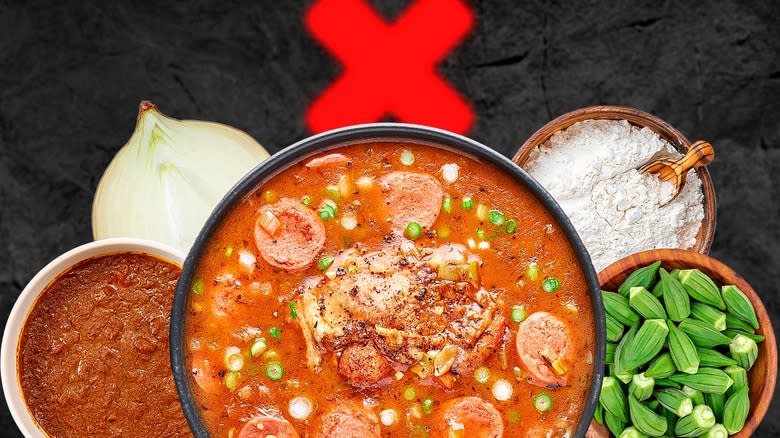
Gumbo is one of the most quintessential staple foods of southeastern Louisiana. Strongly rooted in Creole and Cajun cuisine, this thick and dark soup is a hearty, widely varied, and extremely loved meal in the colder months of the year down south. Gumbo has evolved over the years to contain a variety of ingredients like meat, seafood, vegetables, and thickeners. Because no two gumbos are exactly the same, it's often difficult — and largely debatable — to say exactly what makes a perfect gumbo or a perfect gumbo-making technique.
While there are many right ways to make gumbo, there are plenty more incorrect ways to go about it. Whether making a down-home Cajun gumbo with lots of okra and shrimp or a greenish caramel-colored Gumbo z'herbes with lots of greens, there are some best practices to follow and some common pitfalls to avoid — even amongst the most divisive and opinionated gumbo-making circles.
When I started taking professional cooking seriously after my move to New Orleans from California, my yellow-bellied yuppie self squandered many perfectly good (or getting good) pots of gumbo through the silly mistakes and negligence characteristic of a young cook. The silver lining is that I've put myself through gumbo hell, so I never have to make the same mistakes again, and you, dear reader, never have to at all. If you're ready to take on the love-laden ritual of gumbo making, follow this guide to fast-track your roux-stirring skills.
Read more: Hacks That Will Make Boiling Your Eggs So Much Easier
Undercooking The Roux
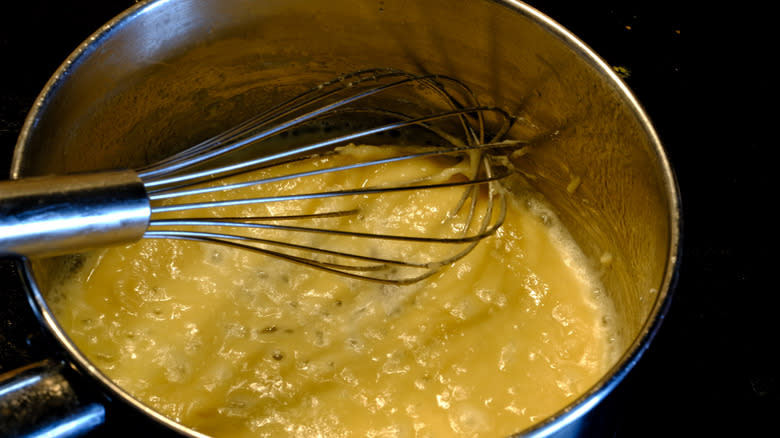
Before getting into the nitty-gritty about what is arguably one of the most important steps to making a good gumbo — that is, making a good roux — it's important to note that not all gumbo uses roux as a thickener. Many of these gumbos implement okra or filé powder made from dried and ground sassafras leaves or both to thicken the stew instead of using flour — a practice from way back when. Today, some folks still make gumbo without roux — a method that is regaining popularity thanks to Melissa Martin, a New Orleans-based Cajun chef from Terrebonne Parish.
That said, most gumbo uses roux, and cooking it enough is vital to your gumbo's flavor. Roux is a mixture of flour and fat (oil or butter or both). The color of your gumbo roux will ultimately depend on the type of gumbo you are making — Cajun roux, for example, can sometimes be darker and nuttier tasting than Creole roux. The color of your roux will darken the longer you cook it and will ultimately change in flavor as it cooks. Whatever color you choose, however, you will want to make sure your roux is properly cooked. An undercooked roux can impart an unpleasant floury taste to your gumbo and won't thicken it properly. Make sure your roux is thoroughly cooked by ensuring the color of your roux is at least a light brown — even for the lightest gumbos.
Using The Wrong Ratio Of Fat To Flour
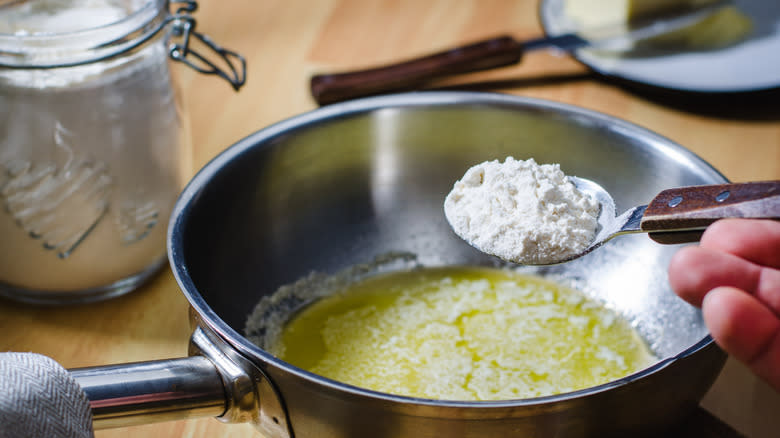
Part of cooking your roux correctly — and therefore, cooking your gumbo correctly — is the ratio of fat to flour used to make your roux. The typical ratio of fat to flour for a gumbo roux is equal parts, 1:1, and that's by weight, not volume. The ratio of fat to flour in making a roux for gumbo is crucial for achieving the desired texture, flavor, and consistency of your stew. A balanced ratio ensures that the roux thickens the gumbo while imparting a rich flavor.
Using an off ratio of flour to fat can pose a number of problems. Using too much flour can cause the flour to clump up in the oil, which will then lead to pockets of flour going uncooked and making the gumbo gritty and floury. Too much oil, and you risk the roux not thickening properly, which can mean a watery gumbo.
Right away, as you whisk the flour into the hot oil, you'll notice the flour start to simmer and transform. A tell-tale sign that you've added the right ratio of flour relative to fat is that the consistency of the roux will be that of wet sand. But you don't have to guess. Investing in a simple kitchen scale will help you measure the proper ratio of flour to fat every time.
Undercooking The Okra In Your Gumbo
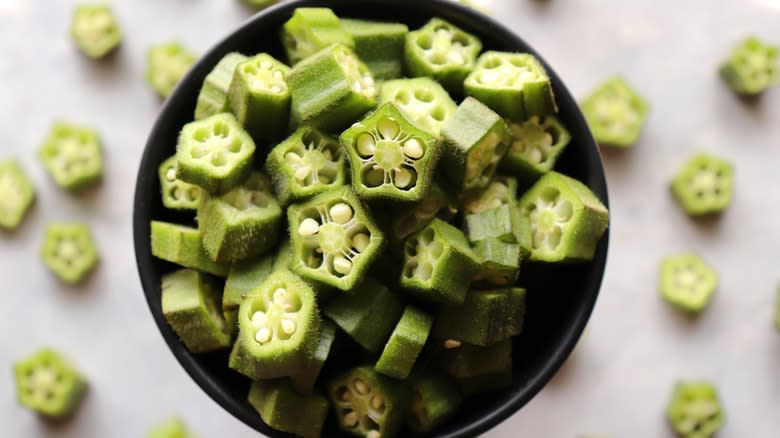
Okra is one of those vegetables that are easy to dislike if you're unfamiliar with it. Many people think it's too fibrous, slimy, or strange to get acquainted with in the kitchen, but okra is a beautiful ingredient when cooked right. Perhaps okra's most defining characteristic is the slime — composed of sugar — inside the pods. The slime, called mucilage, may be texturally and visually revolting to some, but it is actually its best feature, believe it or not.
Okra, called "gombo" in French, has been used to thicken gumbo for centuries. As okra cooks, the mucilage dissolves into liquid because the sugar is water-soluble. The okra no longer tastes slimy, but the liquid takes on its thickening properties, making okra the perfect vegetable for a rich, velvety gumbo. To ensure that the mucilage fully incorporates into the gumbo, however, it's imperative to cook the okra thoroughly.
Undercooked okra will not only likely retain a slimy texture, but it will also taste unpleasantly tough. Okra pods are fibrous and grow stronger and more woody as they get bigger. Make sure your okra is delicious and edible by cooking it long enough so that it becomes tender and soft. Some recipes, like Melissa Martin's chicken and okra gumbo, even call for cooking okra until it completely disintegrates into a thick sludge before adding it to liquid to make gumbo. Ultimately, the way you cook yours will be largely based on the style of gumbo you're making.
Not Using The Holy Trinity
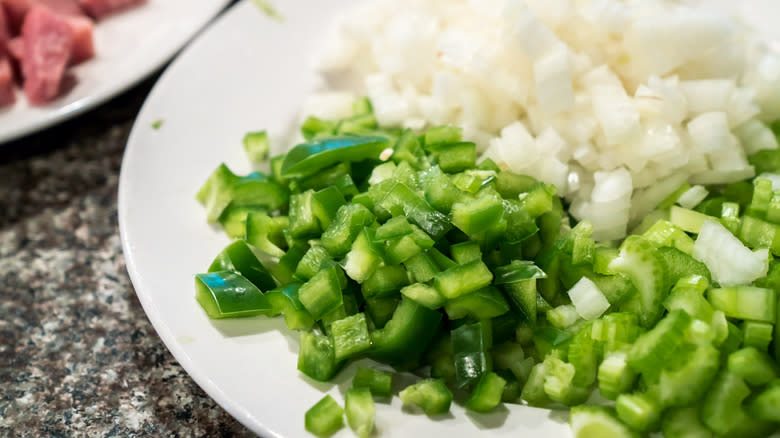
If you've had experience making any sort of soups or stews of the Western world, you're likely acquainted with cooking vegetables like carrots, celery, onions, peppers, garlic, and even tomatoes as the base ingredients of a recipe. The French have word for their trio of carrots, celery, and onions — called mirepoix. Spanish, Italian, and Latin American cuisines more commonly use sofrito — a mixture of garlic, onions, bell peppers, and tomatoes.
In Louisiana's Cajun and Creole cuisines, a similar aromatic vegetable mixture exists, referred to reverently as the holy trinity. It is but a humble mix of onions, green bell peppers, and celery, but lays the foundation of flavors for many of the region's most iconic staples, including jambalaya, red beans and rice, étouffée, and — of course — gumbo. You'll notice that the holy trinity is simply mirepoix featuring a key ingredient swap: bell peppers subbed in place of carrots.
It might seem like an inconsequential swap, but the divine harmony between onions, green bell peppers, and celery in the holy trinity is imperative to the distinct flavor of a traditional gumbo. Onions provide a sweet and savory base, bell peppers add a subtle sweetness and depth of flavor, and celery contributes a slightly bitter and aromatic note. Without using these three ingredients, you won't be able to build the proper and subtle complexities of the vegetables together to create the flavors of an authentic gumbo.
Using Canned Additives In Gumbo
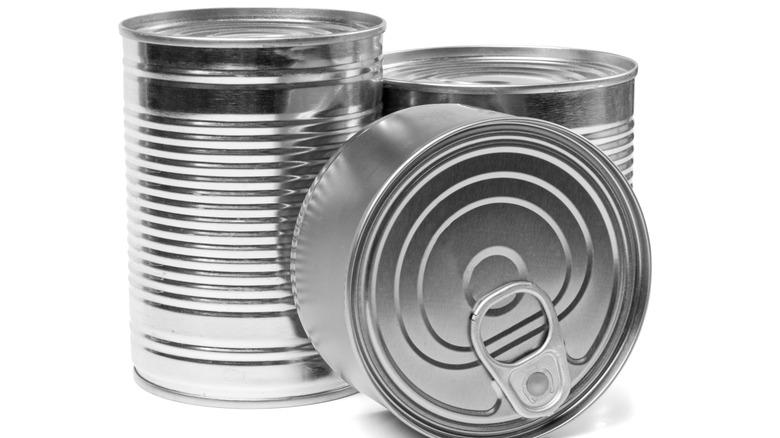
It should go without saying, but using canned and pre-made ingredients in place of fresh and scratch-made will never be an equal trade. There are plenty of tempting corner-cutters and cheat codes lurking in supermarkets near you: Pre-cooked canned roux, canned okra, and even powdered "gumbo base" are all marketed to simplify the act of cooking gumbo — to cut down on the time and effort it requires.
But every step of making gumbo, from stirring the roux to ladling the hot dark stew over a bowl of steaming white rice, is a labor of love. While it may seem convenient at the time, using the manufactured stuff will always make an inferior product. Canned roux, for example, lacks the depth of flavor and authenticity of homemade roux and possibly contains additives, such as extra hydrogenated oils and preservatives, to keep it shelf-stable. Canned vegetables, like okra, lose flavor and texture in the preservation process and will never taste as delicious as fresh, in-season ingredients.
If you want your gumbo to be the best it can be, every step counts. Taking the extra time to make a roux from scratch and cut fresh vegetables will show in the quality of your gumbo when it comes time to eat it.
Adding Proteins At The Wrong Time
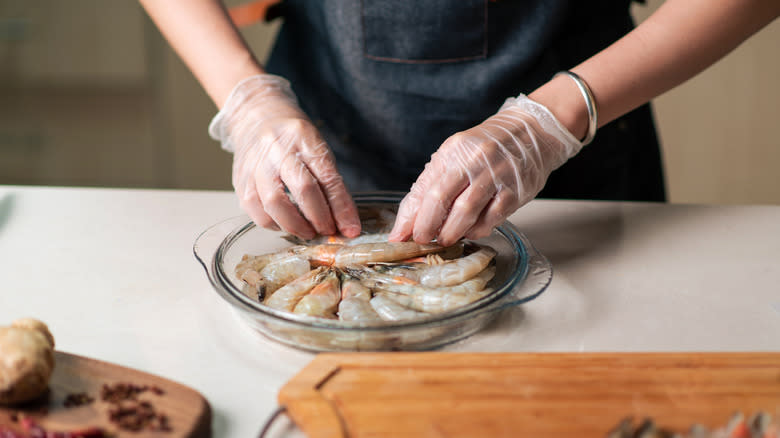
Making gumbo is all about timing. Just as each step of the cooking process is important in its own right, so is their order. If a common life adage is "knowing is half the battle," the same is true for knowing when to cook and add meat to your gumbo. However, doing so will all depend on the type of proteins you plan on adding.
A common mistake in making gumbo — and really, in all stews — is adding certain meats too early and others too late. Crustaceans, for example, are a common gumbo ingredient — namely gulf shrimp, blue crab, and crawfish. Shellfish like these take almost no time to cook through to a perfect pink and plump texture, so the best time to add them is in the last few minutes of cooking, allowing just enough time for them to cook through. Adding crustaceans too early in the cooking process can make them dry and sinewy or tough and rubbery.
Other meats, like raw poultry, should be seared and browned in the roux to develop flavor, then left to simmer with the gumbo after the liquid is added. Adding meats like chicken or duck too late in the game won't allow you to get a good sear on them first, ruling out the opportunity to harness the full potential of their flavor. You also risk undercooking the meat this way. Read your recipe closely so you have your timing down pat.
Not Cooking Holy Trinity In The Roux
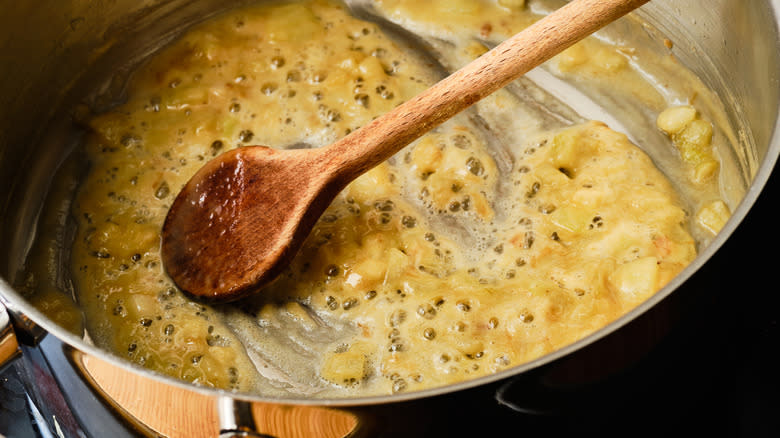
Back to roux! Like plenty of steps in the gumbo train, even cooking the holy trinity is a bit idiosyncratic. Generally speaking, you'll want to cook the vegetables in the roux — not before making the roux, and not after adding liquid. While this instruction is made clear in plenty of gumbo recipes, it's not a common technique outside of making gumbo, so it can cause a lot of confusion.
Sauteing your diced holy trinity in the roux helps the sauce darken by introducing extra sugars and starches to the flour that caramelize while cooking. The fat is also infused in the roux with the flavors and aromas of the vegetables, adding depth of flavor. When the holy trinity is not cooked into the roux — either separately or after the liquid is already added to it — the vegetables don't have the opportunity to release their flavors and aromas into the oil. This means your gumbo won't be as flavorful as it could be. Again, it's all about unlocking the most flavor of every ingredient in every step of the cooking process.
Forgetting To Season Your Gumbo As You Go
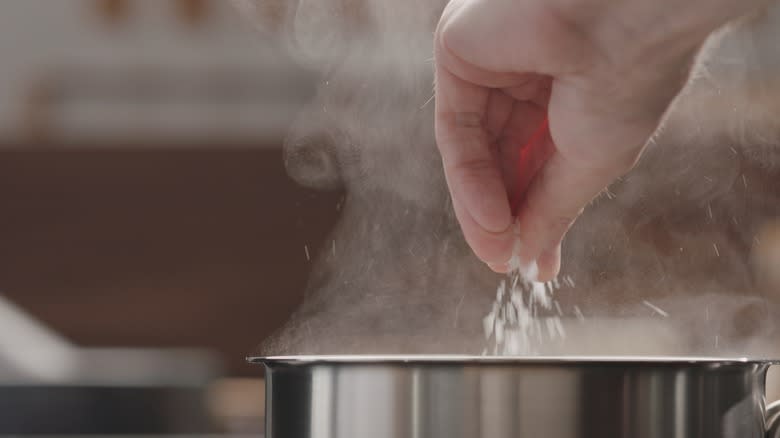
If you watch enough chef cooking demos or read enough technical food writings, you'll eventually come across the phrase "season as you go." It's basically adding salt and spices at every stage of the cooking process, not just all at once or at the end. There are several theories to this, but the main idea behind seasoning as you go is that each of your added ingredients is treated to flavor at every stage of cooking. In doing so, it's easier to quality-control the dish as you cook and taste throughout the process. But there are other reasons, too. Salt also helps ingredients cook faster. Adding salt while sauteing vegetables can break down their cell walls and release moisture faster.
This is all to say that you should definitely not neglect seasoning as you cook gumbo. Tasting and adjusting the seasoning at each stage can ensure the food is neither under-seasoned nor over-seasoned. Not seasoning throughout unnecessarily leaves you in the dark while you're cooking.
Using Water Instead Of Stock
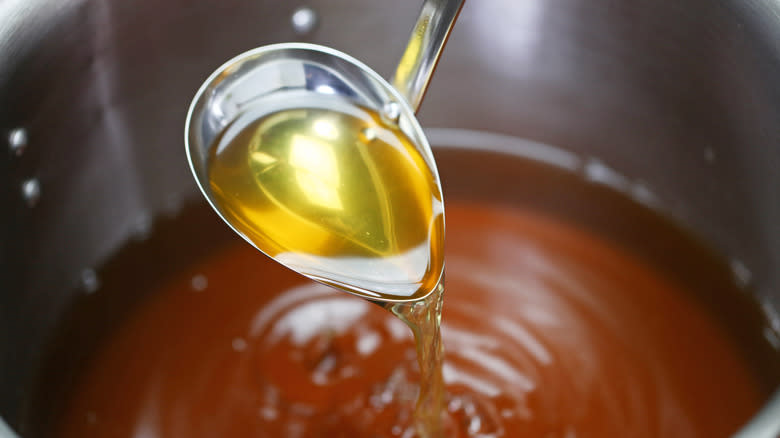
Once you've brought your roux to the perfect color and have cooked off your vegetables and proteins, it's time to simmer your gumbo. What you decide to use as the liquid body of your stew matters just as much — if not more — than any other ingredient in gumbo, and as you may have guessed, choosing the right liquid gives you yet another opportunity to add flavor, texture, and depth. Behind every great gumbo is an even better stock or broth — not plain water.
Though the choice between water and stock might seem inconsequential to some, the difference in your final product is massive. A good, full-bodied stock contains flavors and colors from meat if used, vegetables, herbs, aromatics, and spices. Stock, if made well and simmered to its full potential, will almost always be thicker than water, especially if made with meat like poultry, pork, or beef bones. This body is owed to the natural gelatin released from the collagen in the bones. Water, on the other hand, is completely flavorless and bodiless.
We advise you to steer clear of store-bought stock if you can — it is only marginally more flavorful or thicker than water and is usually mass-produced and of poor quality. Your gumbo will only be as good as your stock, so it will behoove you to take the time to make your own. Make a large batch every so often so you always have homemade stock on hand.
Cooking Your Gumbo Too Fast Or Too Hot
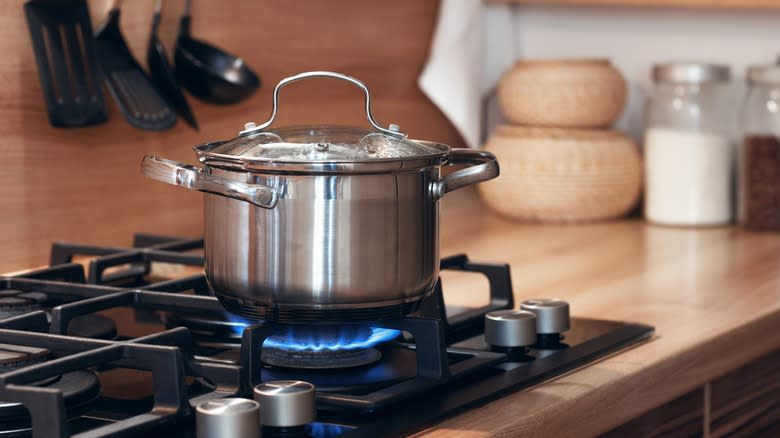
Another old aphorism that speaks to good gumbo cookery is this: You can't rush perfection. Gumbo takes time, and that's because it's best cooked low and slow, namely slowly over low heat. Naturally, there comes a time when impatience gets the best of us or our time management skills are thwarted, and the instinct to rush through a recipe consumes the mind. With a stew like gumbo, which is notoriously time-consuming, it can be easy to want to turn the knob on the burner up and maybe save an extra hour or so of cooking time.
Fight this urge. Gumbo, as you've probably already gathered, can't have a shortcut at any step. Take the roux, for example, which requires slow cooking over low to medium heat to achieve the desired color and flavor without burning. While there are a couple of tricks to make a gumbo roux less intimidating, roux is still a fickle beast. Even a few moments over too-high of heat without constant stirring can burn the roux — a fatal faux pas that'll have you starting all over again.
Simmering shouldn't be rushed through, either. Gumbo turns out best when simmered gently to allow the flavors of the ingredients to meld and develop and the proteins to reach tenderness. Cranking your gumbo from a gentle simmer to a boil can kill its flavor and toughen delicate meats.
Forgetting To Stir The Gumbo
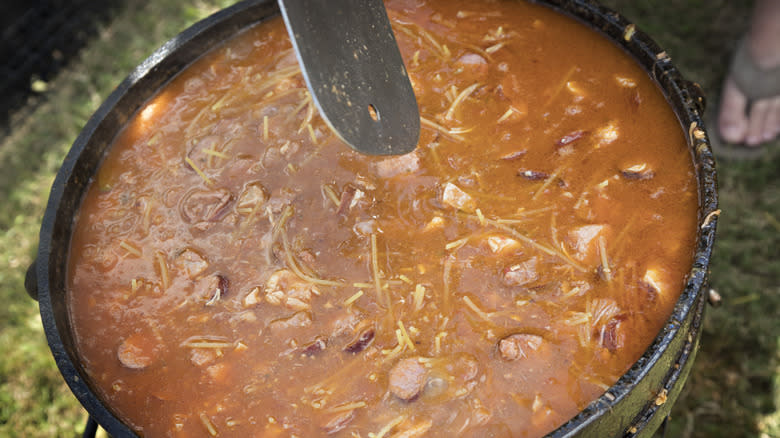
Just as gumbo requires time to become its best self, it also demands a lot of attention. Hopefully, you did some solid stretching before you started cooking because you're in for a lot of stirring.
Since gumbo is so thick, it needs to be stirred very often at every step. Before liquid is added to the pot, the roux needs constant vigorous stirring — ideally with a roux paddle — so it doesn't burn. Once liquid is added, the gumbo should be stirred continuously so that the roux and seasonings fully incorporate into the stock. While simmering, the stew should be stirred, not constantly, but quite often, so that the heat being inducted into the bottom of the pot can more adequately be distributed throughout the liquid.
Gumbo isn't the kind of stew to set on the stove and forget, so try to clear your schedule for a few hours if you plan on whipping up a pot, and make sure you're always close enough to your kitchen to give the pot a good stir. If you forget about your gumbo simmering away, you risk burning all your hard work.
Missing The Proper Seasonings
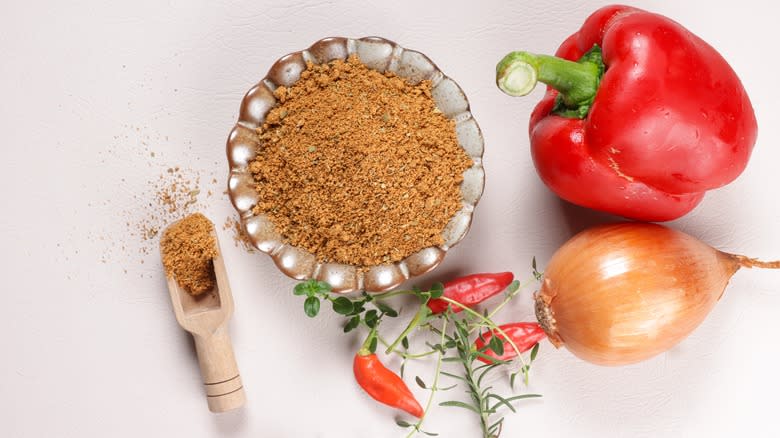
Step inside any Cajun or Creole household, and you'll probably find a well-stocked pantry or larder with numerous seasonings needed for the recipes they hold near and dear. You may not need to stock yourself up with everything a Louisiana culinarian might have, but you should definitely prepare yourself to have the proper seasonings on hand to make a proper gumbo.
Luckily, gumbo doesn't require much, but that also makes each spice, herb, or aromatic all that much more important. Without the few key ingredients on hand, your gumbo just won't taste as authentic as it would with them. And while every gumbo is different, there are some staples shared among most: salt, black pepper, cayenne pepper, paprika, thyme, bay leaves, garlic, filé powder, and Louisiana hot sauce. Build up your pantry ahead of time so you're never running out to the store to frantically search the spice aisle in the middle of making a roux.
Not Serving Gumbo With A Starch
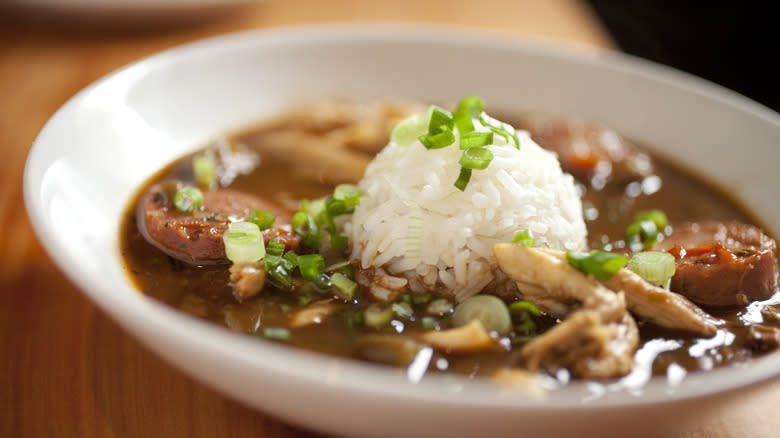
Finally, any good gumbo is incomplete without a proper starch to serve it with. Traditionally, gumbo is served with white rice, but plenty of folks eat their gumbo with potato salad or cornbread, as well. Potato salad in gumbo is more notably rooted in Cajun culture — particularly Vermilion Parish. Cornbread, a common gumbo side on Creole tables, may have origins in gumbo's 17th-century accompaniment of cornmeal mush. But whatever your choice or chosen combination of sides, just make sure you have one.
Gumbo's thick body makes it almost sauce-like, so it's almost improper to eat it without a good, starchy vehicle to soak it up. Rice, the most common gumbo side, is typically cooked separately and served alongside, atop, or underneath the gumbo. The rice serves as a base that complements the rich and flavorful broth of the gumbo, but the same can be said for a good potato salad or cornbread. Whatever you choose, make enough to soak up every last drop.
Read the original article on Tasting Table.

